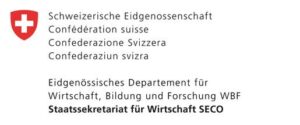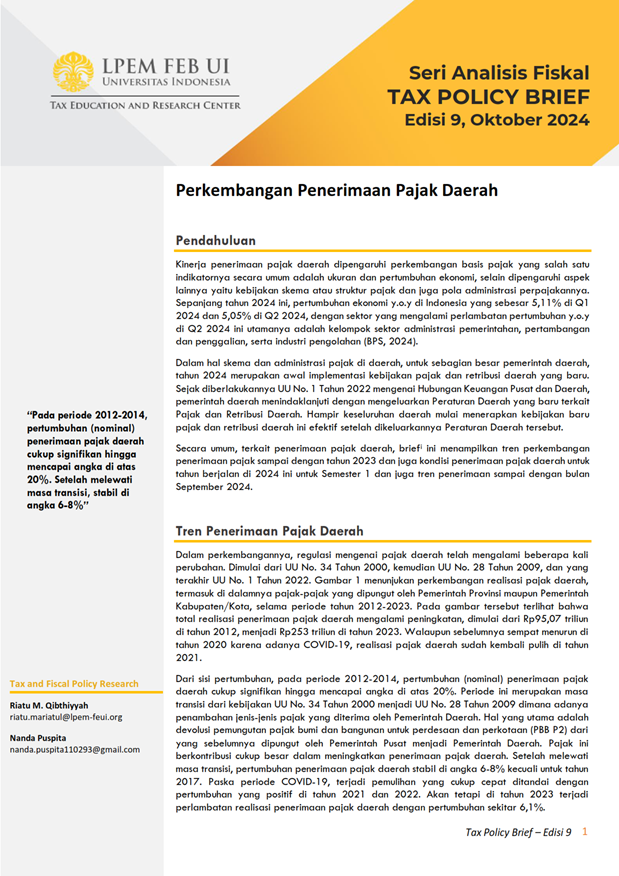Sebagai negara dengan pemerintahan yang terdesentralisasi dan bertingkat, pemerintah daerah di Indonesia memegang peran penting dalam penyediaan layanan dasar, mulai dari pendidikan, kesehatan, hingga infrastruktur lokal seperti jalan, infrastruktur air minum, dan sanitasi. Pada tahun 2023, dari total belanja seluruh pemerintah sebesar 3.476 triliun rupiah, sekitar 38,4% merupakan belanja yang dilakukan oleh pemerintah daerah, yang dimana jika diagregatkan, porsi belanja pemerintah daerah lebih besar dibandingkan dengan porsi belanja pemerintah provinsi (Kementrian Keuangan, 2024a).
Pendanaan untuk penyediaan barang dan jasa publik di tingkat lokal dapat berasal dari transfer antar-pemerintah maupun dari pendapatan asli daerah (PAD). Bagi sebagian besar pemerintah daerah, mayoritas transfer berupa dari dana alokasi umum (DAU). Dalam Undang-Undang Hubungan Keuangan antara Pemerintah Pusat dan Pemerintah Daerah (UU HKPD) yang baru, yaitu Undang-Undang Nomor 1 Tahun 2022, dana perimbangan untuk DAU yang sebelumnya diatur dalam Undang-Undang Nomor 33 Tahun 2004, tidak dinyatakan secara eksplisit dalam undang-undang yang terbaru ini. Sejak tahun 2017, pertumbuhan total transfer antar-pemerintah dari pemerintah pusat berada di bawah 10%, diikuti adanya penurunan dana transfer selama pandemi COVID-19 pada tahun 2020 (Kementerian Keuangan, 2021). Dengan keterbatasan sumber daya fiskal di tingkat pusat, memungkinkan adanya risiko penurunan alokasi transfer antar-pemerintah ke depannya.
Meskipun kebijakan desentralisasi di Indonesia lebih condong ke arah desentralisasi pengeluaran, devolusi serta diskresi atas pendapatan pemerintah daerah juga telah berkembang. Oleh karena itu, pembahasan mengenai otonomi pendapatan daerah menjadi penting dalam memahami bagaimana pemerintah daerah mengelola dan meningkatkan mobilisasi sumber daya daerahnya melalui pendapatan asli daerah dan secara khusus peningkatan dalam pendapatan pajak daerah. Policy brief ini bertujuan untuk mengkaji tren pendapatan pemerintah daerah dengan menilai bagaimana pola pendapatan daerah telah berkembang dari waktu ke waktu, mengevaluasi kapasitas pemungutan pendapatan yang mengacu pada kemampuan pemerintah daerah dalam menghasilkan dan mengumpulkan pendapatan asli daerah secara efektif, serta menyoroti potensi reformasi untuk meningkatkan mobilisasi pendapatan daerah. Secara khusus terkait pendapatan pajak daerah, policy brief ini akan meninjau kinerja pemungutan pajak daerah pada tahun 2024. Perlu dicatat, kami membatasi pembahasan hanya pada pendapatan asli daerah dan pajak daerah di tingkat pemerintah tingkat ketiga yang mengacu pada pemerintah daerah: kota dan kabupaten di Indonesia.
Gambar 1 menunjukkan porsi pendapatan asli daerah di seluruh pemerintah daerah selama periode 2013-2023. Rata-rata, selama sepuluh tahun terakhir, terjadi peningkatan porsi pendapatan asli daerah dari 5,7% pada tahun 2013 menjadi 9,9% pada tahun 2023. Puncak peningkatan porsi pendapatan asli daerah pada tahun 2017 mungkin juga dipengaruhi oleh rendahnya pertumbuhan alokasi transfer antar pemerintah pada tahun tersebut. Perlu dicatat, secara keseluruhan alokasi transfer antar pemerintah ke pemerintah tingkat bawah pada tahun 2017 hanya tumbuh sebesar 6,44% (Kementerian Keuangan, 2017), dan dalam hal ini, transfer yang dialokasikan ke pemerintah daerah mengalami penurunan.
Gambar 1
Terdapat variasi besar antar pemerintah daerah dalam kemampuan mereka untuk mengumpulkan dan memiliki basis yang memadai dalam hal pendapatan asli daerah. Persentil ke-90 yang merujuk pada pemerintah daerah dengan porsi pendapatan asli daerah tertinggi, menunjukkan kinerja yang relatif lebih baik dalam pengumpulan pendapatan asli daerah dengan rata-rata porsi pendapatan asli daerah mencapai 25,4% pada tahun 2023 dari 15,3% pada tahun 2013. Kelompok pemerintah daerah ini sebagian besar adalah pemerintah daerah perkotaan dan sekitar 52% di antaranya merupakan pemerintah daerah di wilayah Jawa. Kelompok persentil ke-90 relatif sama, mengindikasikan bahwa tidak banyak terjadi pengejaran dari pemerintah daerah lain dalam hal mobilisasi pendapatan asli daerah. Pendapatan asli daerah ini terdiri dari pendapatan pajak daerah, pendapatan dari retribusi atau pungutan, keuntungan dari BUMD, dan pendapatan asli daerah lainnya yang sah.
Transfer antar pemerintah masih menjadi sumber pendapatan utama bagi pemerintah daerah di Indonesia. Ketergantungan yang tinggi pada alokasi transfer dari pemerintah pusat ditunjukkan dalam Gambar 2. Meskipun terdapat tren penurunan porsi transfer, beberapa tahun terakhir ditandai dengan peningkatan porsi transfer di semua desil pemerintah daerah. Penurunan porsi transfer antar pemerintah pada tahun 2017 merupakan hasil dari pengurangan transfer ke pemerintah daerah dan karena pemerintah pusat mengalokasikan jumlah transfer yang lebih besar ke tingkat desa. Pada tahun 2017, alokasi dana desa meningkat lebih dari 27% (Kementerian Keuangan, 2017)
Gambar 2
Persentil ke-90 pemerintah daerah dengan porsi transfer antar pemerintah tertinggi sebagian besar merupakan pemerintah daerah di Indonesia bagian timur dan beberapa di antaranya adalah pulau-pulau kecil. Skala ekonomi yang relatif rendah dan kegiatan ekonomi yang terbatas menghambat pembangunan ekonomi di daerah-daerah ini. Dominasi sumber pendapatan dari transfer dapat menyebabkan kondisi soft budget constraint. Mengingat biaya pengeluaran tidak sesuai dengan sumber pendapatan, bagi pemerintah daerah yang memiliki ketergantungan yang sangat tinggi pada transfer antar pemerintah, pemerintah daerah tersebut mungkin lebih rentan terhadap pengeluaran yang tidak efisien dan/atau upaya yang rendah dalam pendapatan asli daerahnya, khususnya dalam pengumpulan pajak daerah. Sementara itu, seperti yang juga ditunjukkan dalam Gambar 2, porsi transfer untuk rata-rata persentil ke-10 pemerintah daerah juga meningkat menjadi 74,4% pada tahun 2023 dari periode terendahnya pada tahun 2017.
Peningkatan porsi transfer antar pemerintah menjadi perhatian selain fragmentasi transfer antar pemerintah di berbagai tingkat pemerintahan, termasuk tingkat administrasi desa. Porsi pendapatan asli daerah yang relatif rendah dapat menjadi disinsentif untuk memobilisasi sumber pendapatan ini, seperti dalam kasus pengumpulan pajak. Dalam hal pendapatan pajak daerah ini, Gambar 3 menunjukkan porsi pendapatan pajak daerah terhadap PDRB yang secara implisit menginformasikan tarif pajak daerah yang efektif.
Pemerintah Indonesia mengadopsi daftar tertutup untuk jenis pajak daerah yang dapat dipungut oleh pemerintah daerah. Kebijakan daftar tertutup pajak daerah ini diadopsi sejak Undang-Undang No. 28 Tahun 2009 tentang pajak daerah diberlakukan dan juga dipertahankan dalam Undang-Undang No. 1 Tahun 2022 yang baru. Dari Gambar 3, rata-rata pendapatan pajak daerah pemerintah daerah belum mencapai 1% dari PDRB-nya. Dalam hal ini, di dalam persentil ke-90 pemerintah daerah pada tahun 2023, hanya ada 18 pemerintah daerah dengan rasio pajak lebih dari 1% dari PDRB-nya, di mana hanya empat pemerintah daerah di luar Pulau Jawa dan Bali-Nusa. Sebagian besar pemerintah daerah ini berada di wilayah dengan sektor pariwisata yang dominan seperti pemerintah daerah di Pulau Bali-Nusa, DI Yogyakarta, dan pemerintah daerah perkotaan di wilayah aglomerasi atau pinggiran DKI Jakarta. Secara keseluruhan, pendapatan pajak pemerintah daerah belum mencapai 1% dari PDB, dan rasio pajak ini relatif rendah dibandingkan dengan negara berkembang lainnya (Bahl et al 2022). Dengan demikian, rata-rata rasio pajak daerah hanya 0,26% seperti yang ditunjukkan dalam Gambar 3, sebagian besar pemerintah daerah di Indonesia memiliki kinerja yang rendah dalam hal pengumpulan pajak daerah.
Gambar 3
Porsi pendapatan pajak daerah terhadap PDRB sedikit menurun pada tahun 2020. Secara rata-rata, porsi pendapatan pajak daerah memiliki tren yang sedikit meningkat meskipun cenderung berfluktuasi terutama ditunjukkan oleh persentil ke-90 pemerintah daerah dengan rasio pajak terhadap PDRB tertinggi. Secara keseluruhan, meskipun pandemi COVID-19 telah memperlambat kegiatan ekonomi, dampaknya terhadap pendapatan pajak pemerintah daerah relatif moderat (Qibthiyyah & Desdiani, 2022). Selama tahun tersebut, terdapat pembatasan mobilitas yang diadopsi oleh beberapa provinsi dan/atau pemerintah daerah terutama di wilayah Jawa, namun hal ini tidak terlalu berdampak pada basis pajak daerah. Perlu dicatat, pendapatan pajak daerah yang utama berasal dari pajak properti untuk daerah perkotaan dan pajak daerah atas konsumsi listrik ritel (rumah tangga) untuk daerah non-perkotaan, dan kedua pajak ini sebagai sumber pendapatan relatif stabil.
Tahun 2024 merupakan tahun pemilihan umum di mana pemilihan diadakan secara serentak di seluruh pemerintah daerah. Dalam hal kebijakan pajak daerah, tahun 2024 juga mungkin menjadi tahun awal di mana pemerintah daerah mengadopsi kebijakan baru tentang pajak daerah seperti yang telah diatur dalam Undang-Undang No. 1 Tahun 2022. Seperti halnya perubahan kebijakan lainnya, ada biaya administrasi terkait dengan implementasi dan adopsi regulasi di tingkat daerah. Selain itu, bagi wajib pajak, perubahan kebijakan pajak daerah mungkin dan mungkin tidak mempengaruhi kepatuhannya tergantung pada desain kebijakan pajak daerah dan administrasinya yang dapat bervariasi di antara pemerintah daerah.
Dalam hal pertumbuhan, seperti yang ditunjukkan dalam Gambar 4, pendapatan pajak daerah pada semester pertama menunjukkan tingkat pertumbuhan tahunan (YoY) yang lebih tinggi, sebagian besar berkisar antara 4% dan 6%. Dari Juli hingga November, tingkat pertumbuhan tetap positif tetapi menunjukkan tren penurunan, mengindikasikan perlambatan dalam pengumpulan. Pada bulan Desember, tingkat pertumbuhan YoY menjadi negatif sebesar -0,65%, menandakan kontraksi dalam pendapatan pajak dibandingkan dengan periode yang sama pada tahun sebelumnya.
Secara keseluruhan, meskipun pengumpulan pajak daerah menunjukkan peningkatan nominal yang stabil, tingkat pertumbuhan yang berfluktuasi dan akhirnya menurun menjelang akhir tahun mungkin mengindikasikan potensi perlambatan ekonomi atau perubahan kebijakan pajak yang memengaruhi pendapatan. Penurunan pendapatan pajak daerah ini tidak terduga terutama karena pada tahun 2024 merupakan tahun di mana pemilihan daerah diadakan di semua wilayah dan umumnya kegiatan ekonomi di seluruh wilayah meningkat.
Gambar 4
Gambar 5 berikut ini menunjukkan pengumpulan pajak daerah di seluruh pemerintah daerah, yang diukur sebagai porsi realisasi pendapatan pajak terhadap anggaran. Pada akhir tahun 2024, terdapat 350 pemerintah daerah yang mengalami kekurangan pendapatan pajak, yang merupakan hampir 70% dari pemerintah daerah yang diamati. Dalam hal tingkat keparahan kekurangan, dari gambar tersebut, kekurangan pendapatan pajak daerah yang lebih dari 50% dari target pengumpulan yang ditetapkan dalam anggaran terjadi di 83 pemerintah daerah, yang merupakan 16,7% dari keseluruhan pemerintah daerah yang diamati. Tingginya jumlah pemerintah daerah dengan kekurangan pendapatan pajak daerah sampai batas tertentu mengindikasikan kinerja pengumpulan pajak pemerintah daerah yang belum optimal.
Gambar 5
Sebaliknya, ada juga pemerintah daerah yang mengumpulkan pajak daerah jauh melebihi anggaran. Namun, masih dipertanyakan apakah hal tersebut mencerminkan kinerja pengumpulan yang baik mengingat perbedaan yang besar dengan anggaran yang ditetapkan, dan dengan demikian dapat disebabkan oleh target pendapatan pajak daerah yang relatif rendah yang ditetapkan dalam anggaran. Perlu dicatat, sebagian besar pemerintah daerah ini memiliki ukuran anggaran yang kecil dan masing-masing memiliki pendapatan pajak daerah yang rendah dalam nilai absolut.
Mobilisasi sumber daya domestik untuk kasus pemerintah daerah di Indonesia perlahan-lahan membaik untuk beberapa pemerintah daerah yang sebagian besar merupakan daerah perkotaan. Persentil ke-90 pemerintah daerah selama sepuluh tahun terakhir, dominasi alokasi transfer antar pemerintah untuk sebagian besar pemerintah daerah di Indonesia telah menurun tetapi meningkat kembali setelah pandemi yang sejalan dengan tren yang relatif datar dalam hal porsi pendapatan asli daerah untuk persentil ke-10 pemerintah daerah.
Dalam hal pendapatan asli daerah ini, sebagian besar pendapatan berasal dari pajak daerah, dan dalam hal kapasitas pajak daerah, ada masalah laten yaitu rendahnya rasio pajak pemerintah daerah. Terdapat kesenjangan yang sangat besar antara tarif pajak daerah yang ditetapkan dan rasio pajak pemerintah daerah di mana pada tahun 2023 untuk rata-rata pemerintah daerah masih hanya 0,26% dari PDRB-nya.
Pada tahun 2024, sekitar 70% pemerintah daerah mengalami kekurangan dalam pengumpulan pajak, mengimplikasikan bahwa pengumpulan pajak pemerintah daerah ini berada di bawah target yang dinyatakan dalam anggaran masing-masing. Dilihat dari realisasi pendapatan pajak dari bulan ke bulan, terjadi penurunan pertumbuhan tahun ke tahun setelah pertengahan tahun dan terdapat pertumbuhan tahunan negatif dari pajak daerah pada Desember 2024.
Dalam konteks pemerintah daerah, mobilisasi pendapatan pajak daerah belum optimal dan tantangan untuk meningkatkan pengumpulan pajak kemungkinan akan berbeda mengingat karakteristik fiskal daerah yang beragam di antara pemerintah daerah di Indonesia. Untuk beberapa pemerintah daerah, mungkin juga ada masalah kurangnya estimasi yang kredibel dalam hal menetapkan target pendapatan.
Ringkasan ini merupakan bagian dari Proyek Pipa Data Fiskal Subnasional yang dilakukan oleh ZHAW dan TERC FEB UI, dan didukung oleh SECO (Sekretariat Negara Swiss untuk Urusan Ekonomi).

Bahl, R., McCluskey, W., Franszen, R., and Li, W. (2022). Bab 1. Konteks dan Analisis Perbandingan, dalam Property Tax in Asia, eds. McCluskey, W., Bahl, R., dan Frenszen, R., Lincoln Institute of Land Policy.
Undang-Undang Nomor 33 Tahun 2004 tentang Perimbangan Keuangan Antara Pemerintah Pusat dan Pemerintah Daerah. Pemerintah Indonesia.
Undang-Undang Nomor 28 Tahun 2009 tentang Pajak Daerah dan Retribusi Daerah. Pemerintah Indonesia.
Undang-Undang Nomor 1 Tahun 2022 tentang Hubungan Keuangan Antara Pemerintah Pusat, Pemerintah Daerah Provinsi, dan Pemerintah Daerah Kabupaten/Kota. Pemerintah Indonesia.
Kementerian Keuangan. (2024). Laporan Keuangan Pemerintah Konsolidasian Tahun 2023, Direktorat Akuntansi dan Pelaporan – Perbendaharaan.
https://djpb.kemenkeu.go.id/portal/publikasi/data/gfs/LKPK/LKPK_2023.pdf
Kementerian Keuangan. (2021). Dua Dekade Desentralisasi Fiskal di Indonesia, Badan Kebijakan Fiskal.
https://fiskal.kemenkeu.go.id/files/buku/file/1661139200_buku_dua_dekade_desentralisasi_fiskal.pdf
Kementerian Keuangan. (2017). Nota Keuangan Pemerintah Tahun 2017, Direktorat Anggaran. https://anggaran.kemenkeu.go.id/assets/FTPPortal/Peraturan/NK%20UU%20APBN%20Lapsem/2017%20Nota%20Keuangan%20APBNP%202017.pdf
Qibthiyyah, R., M., dan Desdiani, N. (2022). Reformasi Pajak Daerah. TERC Tax Policy Brief, edisi ke-2, September.





